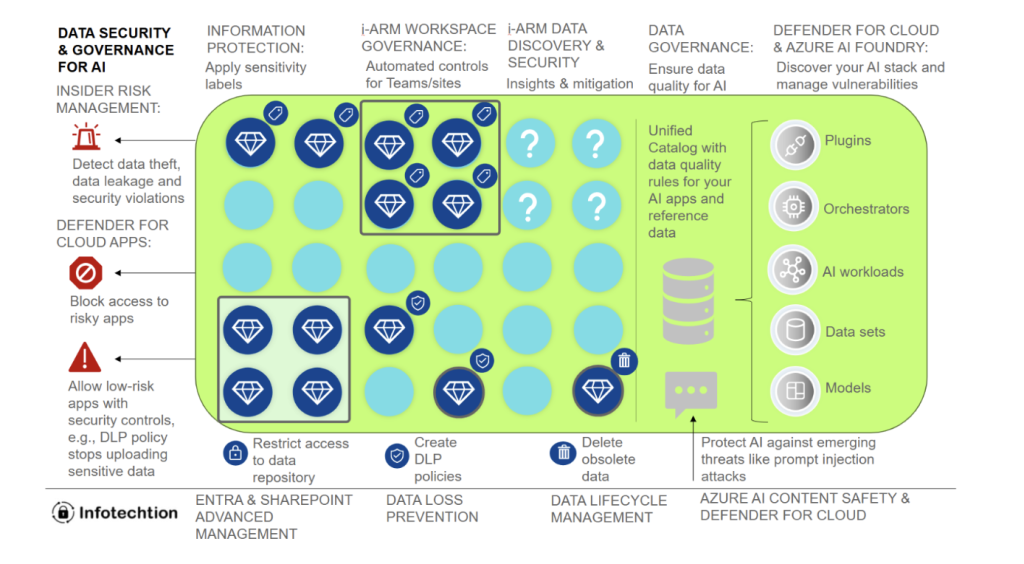![]()
Protecting and Governing AI with Microsoft Solutions
Artificial Intelligence (AI) is revolutionizing industries across the globe, yet its rise brings critical challenges in security and governance that organizations must address proactively. Understanding the risks, implementing robust safeguards, and embracing a Zero Trust strategy are pivotal steps in leveraging AI effectively while mitigating vulnerabilities.
Generative AI: A Game Changer
Generative AI (GenAI) is poised to transform industries, with Gartner predicting its role in 70% of text- and data-heavy tasks by 2025—up from less than 10% in 2023. Additionally, Gartner forecasts that by 2028, multiagent AI for threat detection and response will rise from 5% to 70% of implementations, augmenting staff rather than replacing them. These advancements signal immense growth opportunities but also highlight emerging risks.
George Colony, CEO of Forrester, emphasizes the urgency for organizations to act, stating, “This is the biggest technology/business change of my lifetime… Position yourself not to be a victim. Position yourself to win.”
Challenges in AI Adoption
Organizations face numerous hurdles as they integrate AI into their workflows, including:
- Data leakage: Over 80% of leaders cite sensitive data leakage as their top concern.
- Unmanaged AI apps: 78% of AI users bring unauthorized apps like ChatGPT into work environments.
- Emerging security gaps: 66% of organizations are building or testing AI apps, creating vulnerabilities.
- Regulatory pressures: 55% of leaders lack a clear understanding of AI regulatory requirements.
Sources: First Annual Generative AI study: Business Rewards vs. Security Risks, , Q3 2023, ISMG, N=400; 2024 Work Trend Index Annual Report, Microsoft and LinkedIn, May 2024, N=31,000.; Gartner®, Gartner Peer Community Poll – If your org’s using any virtual assistants with AI capabilities, are you concerned about indirect prompt injection attacks?
Zero Trust Strategy for AI
A Zero Trust model shifts security from network-centric to data- and asset-centric, treating every access request as a potential threat. Its principles include:
Verify Explicitly
- Assess and verify all identities accessing AI apps.
- Monitor both intended and unintended activities.
Use Least Privilege Access
- Ensure AI interacts only with necessary data.
- Apply Just-In-Time (JIT) and Just-Enough-Access (JEA) practices.
Assume Breach
- Treat every user prompt as potentially malicious.
- Expect AI outputs to risk data leakage.
Mitigating AI Risks
Microsoft provides an array of tools to help organizations secure and govern data as they adopt AI.

Solutions include:
Identify Data Leak and Oversharing
Prepare: Secure Sensitive Data
- Use Entra and SharePoint Advanced Management (SAM) to restrict access to sensitive workspaces.
- Apply Purview Information Protection to classify, label, encrypt, and enforce access controls — ensuring only authorized users can access confidential data via Copilot.
- Use Purview Data Lifecycle Management to delete old privacy and obsolete data.
Discover: Find Data Risks Early
- Use Purview Data Security Posture Management (DSPM) for AI to monitor AI usage
- Run oversharing assessments on SharePoint and Copilot to uncover and remediate exposure risks before incidents occur.
Protect: Address Oversharing and Risky Behavior
- Create DLP policies for Microsoft 365 Copilot to block summarization of classified data.
- Use Insider Risk Management to detect anomalous user activity (e.g., repeated sensitive queries).
- Apply Adaptive Protection to dynamically tighten access controls for high-risk users.
Protect: Guard Against Shadow AI Data Leaks
- Use Defender for Cloud Apps to discover and assess SaaS AI app usage.
- Block high-risk AI apps and apply Conditional Access + Endpoint DLP to manage low-risk app usage.
- Restrict sensitive data from being pasted into any AI tools, even approved ones.
Addressing Emerging Threats
Generative AI introduces new vulnerabilities such as prompt injection attacks. Strong security posture at launch is insufficient; active monitoring is essential.
- Defender for Cloud and Azure AI Foundry to discover your AI stack and manage vulnerabilities
- Defender for Cloud and Azure AI Content Safety to protect AI against emerging threats like prompt injection attacks
- Microsoft Purview Data Governance to establish data quality for AI with a Unified Catalog with data quality rules for your AI apps and reference data.
Ensuring Regulatory Compliance
With new regulations like the EU AI Act and NIST AI Risk Management Framework, organizations must adopt comprehensive governance frameworks to stay compliant. Key pillars include:
- AI strategy and policies.
- Risk management frameworks.
- Education and awareness programs.
- Data governance and regular monitoring.
1. Prepare
- Use Microsoft Compliance Manager to get clear guidance on technical controls for AI compliance.
- Communicate requirements effectively to IT and security teams based on regulatory mappings.
2. Discover
- Use Defender for Cloud to discover custom-built AI resources in your cloud environment.
- Use Defender for Cloud Apps to discover and monitor SaaS AI apps used by employees.
- Build an initial catalog of AI systems needing risk assessments.
3. Govern
Enable Microsoft Purview solutions:
- Audit for AI activity tracking.
- Data Lifecycle Management for retention and deletion.
- Communication Compliance for monitoring AI interactions.
- eDiscovery for legal investigation readiness.
- Require developers to document projects using Azure AI Foundry AI reports.
- Conduct Privacy Impact Assessments for all AI apps
- Implement Azure AI Content Safety to prevent harmful or ungrounded AI responses.
Conclusion
AI is undeniably shaping our future, offering unprecedented opportunities alongside critical risks. By adopting Zero Trust principles, leveraging Microsoft’s comprehensive security solutions, and aligning with emerging regulatory requirements, organizations can navigate this transformative era responsibly and effectively.
The path forward demands vigilance, collaboration, and innovation. As AI continues to evolve, security and governance will remain the cornerstone of its successful adoption.
Next steps
Learn how Microsoft security and governance solutions can govern and secure AI



